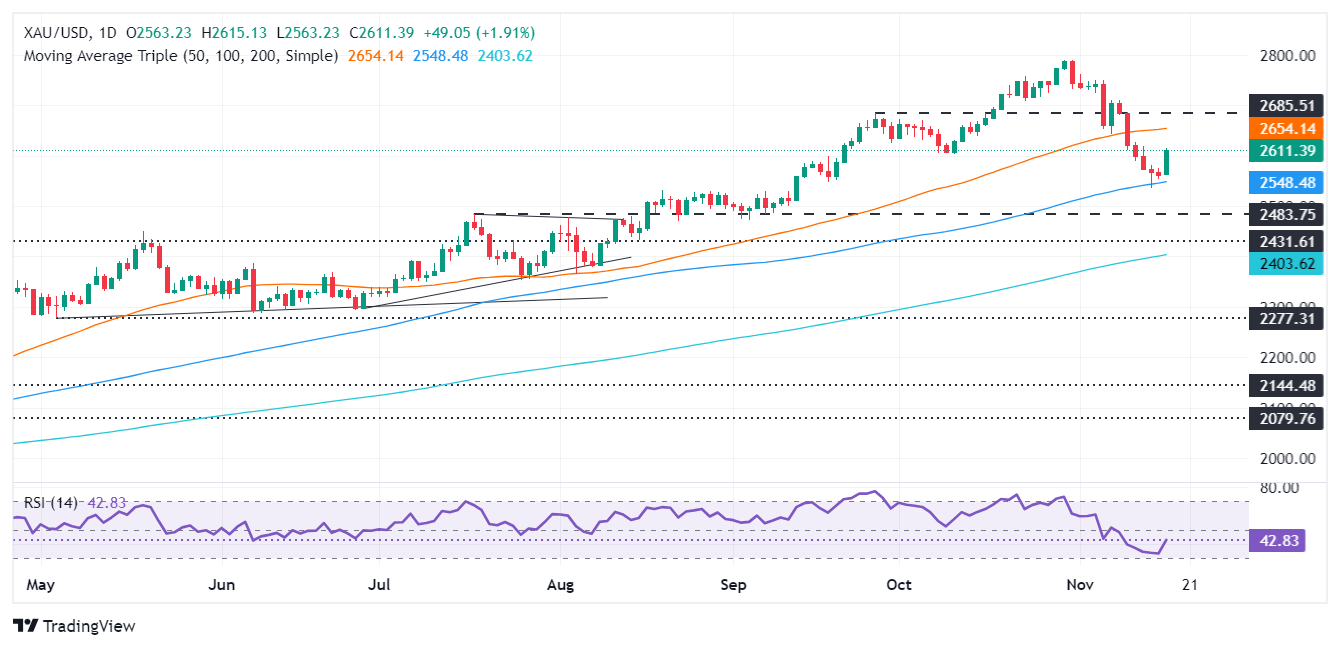Gold hits $2,600 on falling US yields, geopolitical woes

- Gold prices rally over 1.80%, boosted by geopolitical developments and a dip in the US Dollar Index to 106.27.
- Recent US support for Ukraine escalates tensions, influencing safe-haven assets and impacting the Greenback.
- Traders adjust Fed rate cut expectations, with a decrease in the likelihood of a December adjustment from 82% to 62%.
Gold price rallied over 1.80% at the beginning of the week and climbed above $2,600 after falling to a two-month low of $2,536. An escalation of the Russia-Ukraine conflict, along with a weak US Dollar, opened the door for Gold’s leg up on Monday. At the time of writing, XAU/USD trades at $2,610.
Wall Street sentiment is mixed. Two of the four largest US equity indices trade with gains, while the other two fluctuate. Geopolitics continued to drive the bullion’s price action after Russia’s massive attack on Ukraine triggered a reaction by the White House.
Recently, two officials revealed that US President Joe Biden authorized Ukraine’s use of long-range missiles inside Russia, CNN revealed. The decision comes as a reaction to thousands of North Korean troops being deployed in support of Moscow’s war effort.
This weighed on the Greenback, which, according to the US Dollar Index (DXY) that tracks the buck’s performance against a basket of six currencies, dropped some 0.38% to 106.27.
Nevertheless, former US President Donald Trump’s victory bolstered the Greenback on fears that tariffs and lower taxes are seen as potential drivers of inflation and might slow the Fed’s easing cycle.
The Fed is expected to lower borrowing costs for the third straight meeting in December. Nevertheless, recent data has witnessed investors trimming the odds from an 82% chance of an imminent cut of 25 basis points (bps) to 62%, according to CME FedWatch Tool data.
Ahead of this week, the US economic schedule will feature housing data, Initial Jobless Claims, S&P Global Flash PMIs, and the University of Michigan (UoM) final reading of Consumer Sentiment for November.
Gold price soars amid a weak US Dollar
- Gold prices recover as US real yields, which inversely correlate against bullion, fall three basis points to 2.088%.
- US Treasury bond yields were also pressured ahead of the weekend, with the 10-year benchmark rate down two basis points to 4.42%.
- Boston Fed Susan Collins said the US central bank does not urgently need to lower rates. Lastly, Chicago’s Fed Austan Goolsbee kept the central bank options open regarding December’s meeting, adding, “The dispute on neutral rate could support slower cuts.”
- According to data from the Chicago Board of Trade via the December fed funds futures contract, investors are pricing in 24 basis points of Federal Reserve rate cuts by the end of 2024.
Gold price recovers as buyers target 50-day SMA
Gold price resumed its upside as expected, following November 14, once a ‘hammer’ was formed, which opened the door for a rebound. Once XAU/USD has risen above the October 10 swing low of $2,603, buyers emerged and eyed the 50-day SMA at $2,653, with further resistance around $2,700. Exceeding this could pave the way to the November 7 high of $2,710.
On the other hand, further losses are seen below the November 14 swing low of $2,536, but firstly, traders will face the 100-day Simple Moving Average (SMA) at $2,547. Once those two levels are taken, Gold’s next support would be $2,500.
The Relative Strength Index (RSI) has moved away from its neutral line, indicating bearish momentum that could lead to further declines in XAU/USD.
Risk sentiment FAQs
In the world of financial jargon the two widely used terms “risk-on” and “risk off” refer to the level of risk that investors are willing to stomach during the period referenced. In a “risk-on” market, investors are optimistic about the future and more willing to buy risky assets. In a “risk-off” market investors start to ‘play it safe’ because they are worried about the future, and therefore buy less risky assets that are more certain of bringing a return, even if it is relatively modest.
Typically, during periods of “risk-on”, stock markets will rise, most commodities – except Gold – will also gain in value, since they benefit from a positive growth outlook. The currencies of nations that are heavy commodity exporters strengthen because of increased demand, and Cryptocurrencies rise. In a “risk-off” market, Bonds go up – especially major government Bonds – Gold shines, and safe-haven currencies such as the Japanese Yen, Swiss Franc and US Dollar all benefit.
The Australian Dollar (AUD), the Canadian Dollar (CAD), the New Zealand Dollar (NZD) and minor FX like the Ruble (RUB) and the South African Rand (ZAR), all tend to rise in markets that are “risk-on”. This is because the economies of these currencies are heavily reliant on commodity exports for growth, and commodities tend to rise in price during risk-on periods. This is because investors foresee greater demand for raw materials in the future due to heightened economic activity.
The major currencies that tend to rise during periods of “risk-off” are the US Dollar (USD), the Japanese Yen (JPY) and the Swiss Franc (CHF). The US Dollar, because it is the world’s reserve currency, and because in times of crisis investors buy US government debt, which is seen as safe because the largest economy in the world is unlikely to default. The Yen, from increased demand for Japanese government bonds, because a high proportion are held by domestic investors who are unlikely to dump them – even in a crisis. The Swiss Franc, because strict Swiss banking laws offer investors enhanced capital protection.
